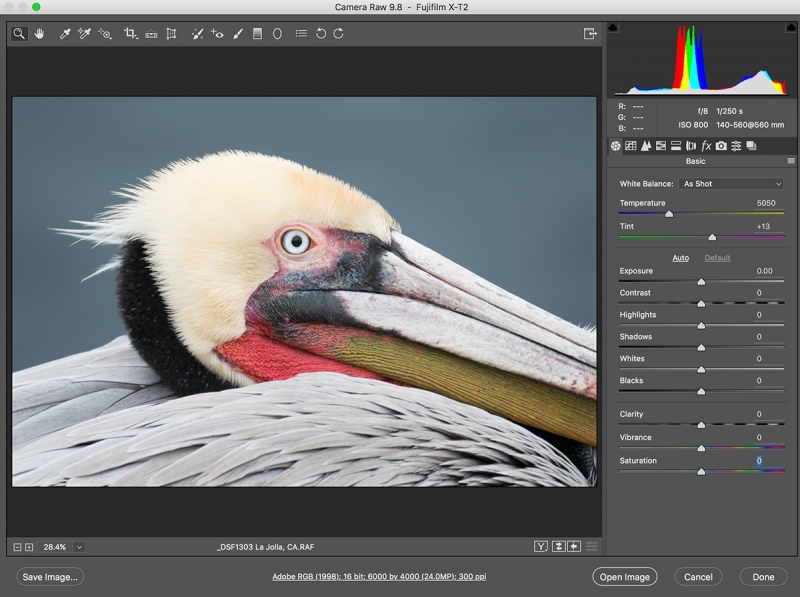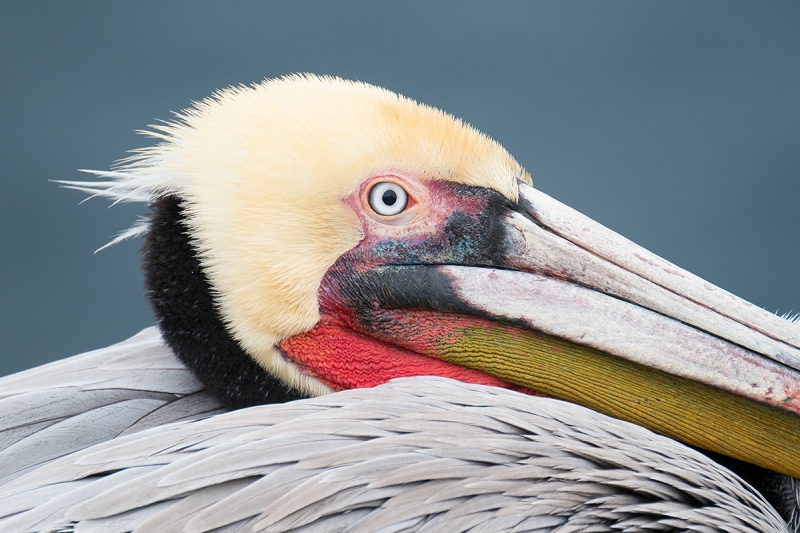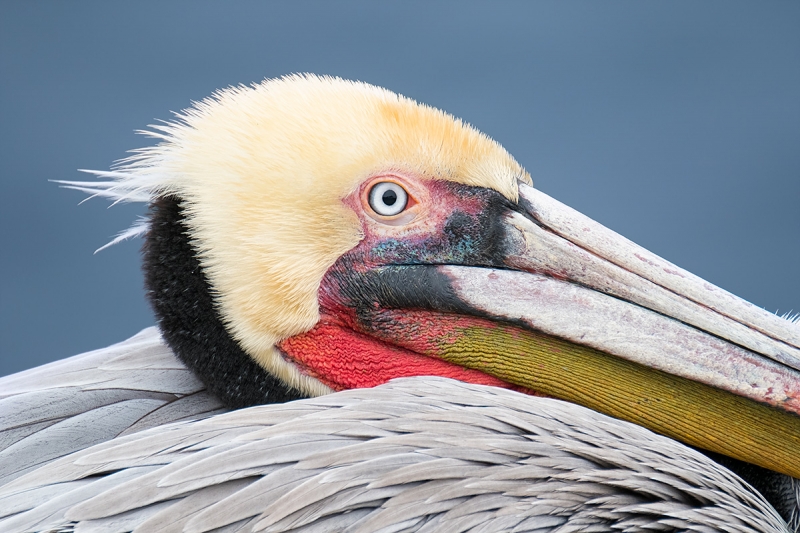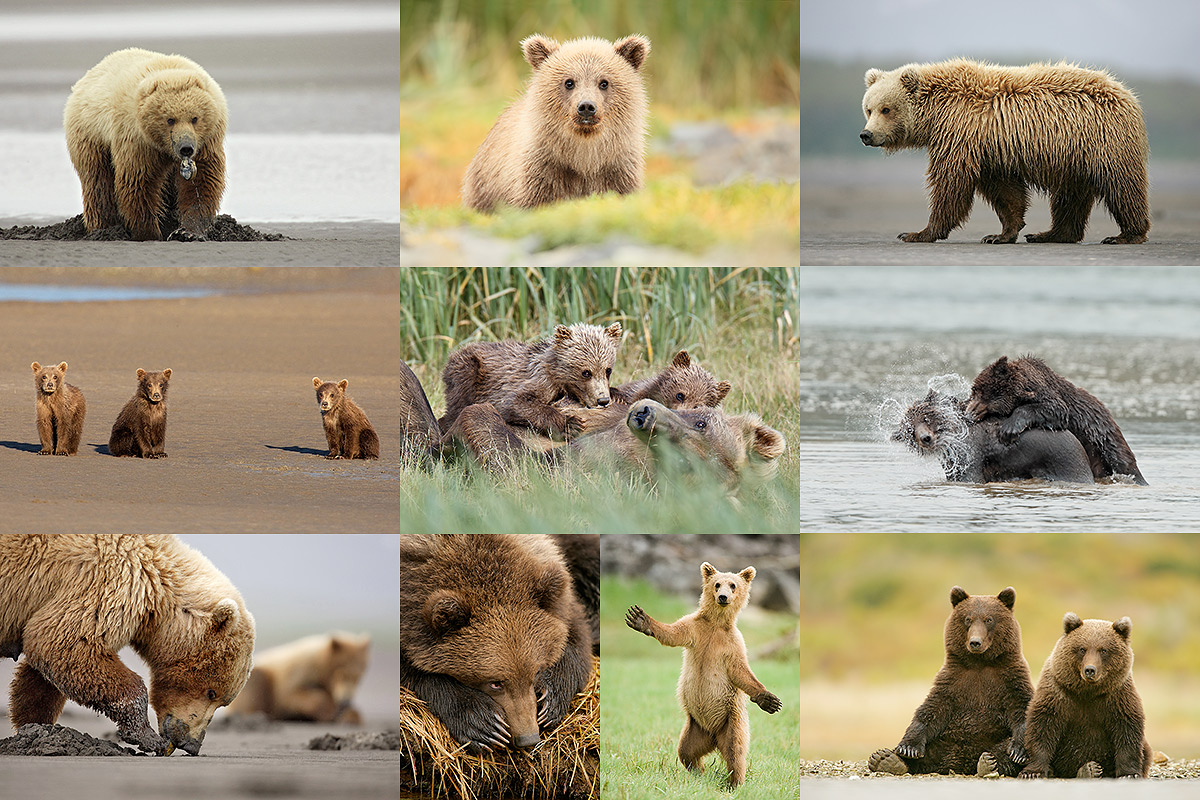What’s Up?
On Sunday morning Patrick Sparkman and I were amazed when we showed up at the cliffs in La Jolla to find zero pelicans. We hung out for a while and zero pelicans flew in. There were about a dozen photographers. By 7:30, we decided to go find something. We did. I took Patrick to one of my favorite spots along the low cliffs, a few hundred yards north of the Green Patch. We had lots of great chances with a variety of shorebirds and handsome gulls. Though I had my Canon gear with me I never used it, opting instead to continue with the Fujifilm gear. As the sun finally came out, I had a chance to try the 2X TC. I had fun enjoying 1200mm of reach in an easily hand holdable package. With the finally bright conditions, AF performed better than expected.
It was the first time in 33 years that I visited the cliffs in winter and did not see a single pelican. Ask me if I am worried for the IPT.
Gear Questions and Advice
Too many folks attending BAA IPTs and dozens of folks whom I see in the field, and on BPN, are–out of ignorance–using the wrong gear, especially when it comes to tripods and more especially, tripod heads… Please know that I am always glad to answer your gear questions via e-mail.
The Streak: 423!
Today’s blog post marks a totally insane, irrational, illogical, preposterous, absurd, completely ridiculous, unfathomable, silly, incomprehensible, what’s wrong with this guy?, makes-no-sense, 423 days in a row with a new educational blog post. As always–and folks have been doing a really great job recently–please remember to use our B&H links for your major gear purchases. For best results use one of our many product-specific links; after clicking on one of those you can continue shopping with all subsequent purchases invisibly tracked to BAA. Your doing so is always greatly appreciated. Please remember: web orders only. And please remember also that if you are shopping for items that we carry in the new BAA Online Store (as noted in red at the close of this post below) we would of course appreciate your business.
Adding the 1.4X Teleconverter to the Fujifilm Mix …
As always when you add a teleconverter to a telephoto or super-telephoto lens, there are pluses and minuses. The big plus is that your lens becomes 40% longer. The big minus is that you lose a stop of light thus slowing AF and requiring an additional stop of ISO that brings with it an additional stop of noise. In addition, the one stop loss of light slows the speed of initial AF acquisition. And while sharpness is always reduced to some degree, your results with the modern lenses with either teleconverter can be spectacularly sharp because the lenses are so incredibly sharp do begin with, even at their wide open apertures.
My experience when the Fujinon 1.4X TC is added to the 100-400/XT-2 combination reflected all of the above. My hand holdable 600mm f/5.6 lens (effective) became a hand holdable 840mm (effective) f/8 lens. Initial AF acquisition, slow to begin with with the XT-s, slowed even more. But, with the amazing optical image stabilization system, the images, once the camera focused, were extremely sharp. As AF is via contrast on the sensor, there is no need to FocusTune/micro-adjust the Fujifilm gear; everything that is focused is razor sharp. The Fujinon 100-400 shows very little if any vignetting, even wide open at f/5.6 with the lens alone or at f/8 with the TC added. Additionally, the XT-2 offers excellent control of high ISO noise so raising the ISO is not a problem.
Two unforeseen problems arose with the addition of the 1.4X.
1-At times, the AF points on the periphery of the AF grid simply could not acquire focus. When I switched to the next AF point closer to the center, AF performed just fine. And once the XT-2 acquires AF if does not let go and as noted before, the images are incredibly sharp.
2-A times, after pressing the joystick in, I could not select a different AF point using the joystick. This problem was mysteriously intermittent. I will be talking with one of the top two Fujifilm tech reps early this week and will share what I learn here.
Brown Pelican, Pacific race, tight face and bill detail |
XT-2 RAW (RAC) Color Out-of-Camera
As noted yesterday, and as seen above, the RAW file color out-of-camera with XT-2 images with the ACR default settings is flat and boring. But that is why we create with RAW capture. (Note: folks using JPEG capture can juice up the color in-camera, but this approach is not at all recommended. Why? If you screw up the exposure with JPEGs you are screwed. There are lots of other reasons to use RAW only; they are covered in detail in ABP II.)
Note the perfect histogram. As noted yesterday, it is easy to adjust your manual exposure settings with the XT-2 without making a test exposure and without checking the histogram as with the electronic viewfinder you are actually seeing the exposure in the viewfinder. Changes to the aperture or shutter speed are reflected through the viewfinder instantly …
The Converted RAW file saved as a TIFF: Brown Pelican, Pacific race, tight face and bill detail |
Adjusting the Color in ACR
As we saw clearly in the ACR screen capture in yesterday’s blog post here, a few small tweaks when converting an XT-2 RAW (RAC) file can make a world of business. I did similar things to the same sliders that I adjusted for that image. Heck, it is the same bird just with the TC added.
My only problem with the color of the converted TIFF is the color of the BLUE water. Keep reading to learn how I handled that.
|
This image was created at La Jolla, CA with the hand held the Fujifilm XF 100-400mm f/4.5-5.6 R LM OIS WR lens, the Fujifilm XF 1.4x TC WR teleconverter, and the Fujifilm X-T2 Mirrorless Digital Camera equipped with the Fujifilm VPB-XT2 Vertical Power Booster Grip. ISO 800. Evaluative metering +2/3 stop: 1/1250 sec. at f/8 in Manual mode. AWB. Shutter Button Continuous Autofocus. Additional AF information is currently unavailable. Brown Pelican, Pacific race, tight face and bill detail |
Fixing the BLUEs
Once I brought the converted RAC file into Photoshop as a TIFF I applied a layer of my NIK Color Efex Pro 25/25 recipe to a duplicate layer of the whole image, added a Hide-All (Inverse or Black) Mask and painted in the effect on the bird only with a very large brush after hitting B (brush) and D (to set the default). I merged that layer and made a second duplicate layer and applied White Neutralizer to the whole layer, added a Regular Layer Mask, and painted the effect away on the bird with a large brush after hitting B (Brush), D (Default), and X (Switch the default). All of the above from the Layer Masking for Dummies in Digital Basics.
The White Neutralizer did a nice job with the somewhat ugly blue sky.
Digital Basics is an instructional PDF that is sent via e-mail. It includes my complete (former PC) digital workflow, dozens of great Photoshop tips, details on using all of my image clean-up tools, the use of Contrast Masks, several different ways of expanding and filling in canvas, all of my time-saving Keyboard Shortcuts, the basics of Quick Masking, Layer Masking, and NIK Color Efex Pro, Digital Eye Doctor techniques, using Gaussian Blurs, Dodge and Burn, a variety of ways to make selections, how to create time-saving actions, and tons more.
Learn advanced Quick Masking and advanced Layer Masking techniques in APTATS I & II. You can save $15 by purchasing the pair.
You can learn to apply Neat Image noise reduction in The Professional Photographers Guide to Post Processing by Arash Hazeghi and yours truly.
I am working on an all new Current Workflow e-guide that better reflects my Macbook Pro/Photo Mechanic/DPP 4/Photoshop workflow. It will include a section on ACR conversions and a simplified method of applying Neat Image noise reduction.
I am quite pleased by the color, contrast, sharpness, and image quality of the XT-2 images.
|
Images and card copyright Arthur Morris/BEARS AS ART 🙂 |
2017 Bear Boat Coastal Brown Bear Cubs IPTs: July 18-24, 2017 from Kodiak, AK: 5 FULL & 2 Half DAYS: $6699. Happy campers only! Maximum 8/Openings 3.
Join me in spectacular Katmai National Park, AK for six days of photographing Coastal Brown Bears. Mid-July is prime time for making images of small, football-sized cubs. The cubs, and these dates, are so popular that I had to reserve them three years in advance to secure them. There are lots of bears each year in June, but the mothers only rarely risk bringing their tiny cubs out in the open in fear of predation by rival bears. In addition to making portraits of both adults and cubs, we hope to photograph frolicking and squabbling youngsters and tender nursing scenes. At this time of year, the bears are either grazing in luxuriant grass or clamming. There will also be some two- and three-year old cubs to add to the fun. And we will get to photograph it all.
We will live on our tour operator’s luxurious new boat. At 78 feet long its 24 foot beam makes it quite spacious as well. And the food is great. We will likely spend most of our time at famed Geographic Harbor as that is where the bears are generally concentrated in summer. On the odd chance that we do need to relocate to another location we can do so quickly and easily without having to venture into any potentially rough seas. We land via a 25 foot skiff that has lots of room for as much gear as we can carry.
Aside from the bears we should get to photograph Horned and Tufted Puffin and should get nice stuff on Mew Gull, Glaucous-winged Gull, Black-legged Kittiwake, Harbor Seal, and Steller’s Sea Lion as well. A variety of tundra-nesting shorebirds including Western Sandpiper and both yellowlegs are also possible. Halibut fishing (license required/not included) is optional.
It is mandatory that you be in Kodiak no later than the late afternoon of July 17 to avoid missing the float planes to the boat on the morning of July 18. Again, with air travel in Alaska (or anywhere else for that matter) subject to possible delays, being on Kodiak on July 16 is a much better plan.
Barring any delays, we will get to photograph bears on our first afternoon and then again every day for the next five days after that, all weather permitting of course. On our last morning on the boat, July 24, those who would like to enjoy one last photo session will have the opportunity to do so. The group will return to Kodiak via float plane from late morning through midday. Most folks will then fly to Anchorage and to continue on red-eye flights to their home cities.
What’s included? 7 DAYS/6 NIGHTS on the boat as above. All meals on the boat. National Park and guide fees. In-the-field photo tips, instruction, and guidance. An insight into the mind of a top professional nature photographer; I will constantly let you know what I am thinking, what I am doing, and why I am doing it. Small group image review, image sharing, and informal Photoshop instruction on the boat.
What’s not included: Your round trip airfare to and from Kodiak, AK (almost surely through Anchorage). Your lodging and meals on Kodiak. The cost of the round-trip float plane to the boat and then back to Kodiak as above. The cost of a round trip last year was $550. The suggested crew tip of $200.
Have you ever walked with the bears?
Is this an expensive trip? Yes, of course. But with 5 full and two half days, a wealth of great subjects, and the fact that you will be walking with the bears just yards away (or less….), it will be one of the great natural history experiences of your life. Most folks who take part in a Bear Boat IPT wind up coming back for more.
A $2,000 per person non-refundable deposit by check only made out to “BIRDS AS ART” is required to hold your spot. Please click here to read our cancellation policies. Then please print, read, and sign the necessary paperwork here and send it to us by mail to PO Box 7245, Indian Lake Estates, FL 33855.
Your deposit is due when you sign up. That leaves a balance of $4699. The next payment of $2699 will be due on September 15, 2016. The final payment of $2000 is due on February 15, 2017. We hope that you can join me for what will be a wondrously exciting trip.
Please Remember to use my Affiliate Links and to Visit the New BAA Online Store 🙂
To show your appreciation for my continuing efforts here, we ask, as always, that you get in the habit of using my B&H affiliate links on the right side of the blog for all of your photo and electronics purchases. Please check the availability of all photographic accessories in the New BIRDS AS ART Online Store, especially the Mongoose M3.6 tripod head, Wimberley lens plates, Delkin flash cards and accessories, and LensCoat stuff.
As always, we sell only what I have used, have tested, and can depend on. We will not sell you junk. We know what you need to make creating great images easy and fun. And please remember that I am always glad to answer your gear questions via e-mail.
I would of course appreciate your using our B&H affiliate links for all of your major gear, video, and electronic purchases. For the photographic stuff mentioned in the paragraph above, and for everything else in the new store, we, meaning BAA, would of course greatly appreciate your business. Here is a huge thank you to the many who have been using our links on a regular basis and those who will be visiting the New BIRDS AS ART Online Store as well.
Be sure to like and follow BAA on Facebook by clicking on the logo link upper right. Tanks a stack.
Typos
In all blog posts and Bulletins, feel free to e-mail or to leave a comment regarding any typos or errors. Just be right :).


















Interesting information on the Fuji website here regarding the two types of AF detection used in the XT2 (both phase and contrast AF points – I believe the phase points are center loaded):
http://www.fujifilmusa.com/products/digital_cameras/x/fujifilm_x_t2/features/page_02.html
Enjoy multiple aspects of the Fuji system in many photographic situations – but doesn’t seem to me to come close yet to Canon on AF acquisition speed . . . but could just be the operator!
Initial AF Acquisition is pathetic at best. Not a camera for flight and action stuff …
I will check out the link.
thanks, a
Seems like an awful lot of steps to get the final image from the Fugi.
30 seconds work but now using the ACR Astia Soft pre-set for the XM-2. That eliminates several sliders and looks great too. Thanks to a comment on yesterday’s blog post by Mike Ross.
a
Well I just bought the Canon 100-400 L IS 11 to take advantage of the discount! Plan to use with 7D11 It’s still in the box waiting for your final comparison. Not sure I’d want to learn a whole new system. Does the Sony compare too? I do like 10 fps or more. I thought the beak on the image yesterday looked soft and over sharpened but today’s images are gorgeous!
Good luck. Hope that you used my link. Agree that this one is a bit sharper but yesterday’s image was acceptably sharp for me.
a
Yes I used the link! let me know if it doesn’t show up. 🙂
The image looks incredibly sharp to my eyes!
Me too.
a
Arnie,
I bought a canon m5 to add to my mix of Canon cameras. Here is what I found: The camera has the same sensor (or close to) the 80d which has a better sensor than my 7d2. The camera’s af in low light is worse than terrible to be blunt. The m5 is not a bif camera as Canon has not provided all the af options in say a 7d2. But if one is patient one can capture fast flying nearby birds. I am not sure how to attach or embed the image, but I would be glad to send it to you. It is of an acorn woodpecker flying his full speed maybe 15 yards away with my fantastic, very cheap 55-250 stm lens. My conclusions are: Cameras with efv’s are smaller and for me much lighter; the technology is improving very fast and for those where weight and bad backs are a factor, they can take acceptable images; plus as you said there is no need for micro/camera lens adjustments. And, in the case of the M5 all my canon lens can be used. Is it a perfect bif camera, not even close, but for lite and small in good light it is great.
PS My only concern will Canon improve the line especially the af or let it rot? My guess is this depends upon the competition on how well their etf cameras are doing. My hope is that Nikon out does the m5 by a big mile and takes sales away from Canon.
Byron. Your comment is confusing to me. What is a canon m5?
Artie: A Canon M5 is Canon’s latest mirrorless camera. It has the same 24 MP sensor as the APS-C Canon 80D. It was released in the U.S. this past October, earlier elsewhere. If you want, you can read quite a lot about it here:
https://www.dpreview.com/reviews/canon-eos-m5-review
Good luck with the pelicans. I wonder if the rain has anything to do with their scarcity.
Maybe it’s just my aging eyes but these images look a touch soft compared to similar images you have published previously. Could it be just a difference in contrast and color?
With regards to the optimized image, and with all due respect, I think that you might want to have your aging eyes checked. The images looked extremely sharp to both my again eyes and to Patrick’s Sparkman’s young eagle eyes.
later and love, artie